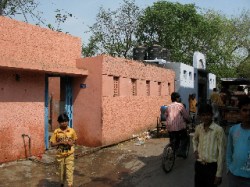The failure of governments in both rich and poor countries to prioritize basic sanitation is killing thousands of children every day, according to two reports released today by WaterAid and PATH. And a third report released yesterday suggests that the global economic crisis may increase the death rate, at least in Africa.

Kevin FergusonPublic toilets in the developing world are fairly uncommon. Those that are available often fall into disrepair and disuse. Above, one of the glitzier examples of public plumbing in the slums of Delhi, India.
All three reports offered this constructive advice: Promote access to drinking water, sanitation, and hygiene together as part of national health care agendas. “It’s just unfathomable that so little development aid is going to stop this enormous global killer,” says John Sauer, communications director for Water Advocates, a nonprofit group that works with PATH and WaterAid. “There’s no excuse not to prioritize funding for very simple, low-cost interventions. This is solvable.”
The World Health Organization estimates that 28 percent of the 9.7 million children who die before the age of 5 every year do so because of poor sanitation and unsafe water. Ironically, that death rate may climb because “the recent and positive focus on … the delivery of health services” does not include preventative measures, such as providing proper sanitation, according to the WaterAid report. The report does not call for diarrhea prevention and treatment to be given preference over other diseases, just that it be included in the mix.
Likewise, the PATH report, titled “Diarrheal Disease: Solutions to Defeat a Global Killer,” notes that over the last decade, momentum has slowed, with declines in research and funding commitments and competing global health priorities. “The perceived lack of urgency and taboo nature of the illness may have also contributed to the current low level of awareness surrounding the issue,” states the PATH report.
Diarrhea, linked directly to unclean water and poor sanitation, is the second-biggest killer of young children, after acute respiratory infections, according to the WHO. That makes diarrhea, causing 17 percent of these deaths, more deadly than measles, malaria, and HIV/AIDS combined, says WHO. When acute respiratory infections are factored in — hand washing with soap and clean water greatly reduces the incidence of respiratory infections, according to a 2005 report published in The Lancet — the mortality rate climbs to about 40 percent.
The reports did offer some good news. Some countries have learned to coordinate water and sanitation programs, says the WaterAid report: “Senegal is an example of a country that has got it right. The distribution of tasks and responsibilities between these structures was decided by an inter-ministerial decree, and the system is functioning well.” Ethiopia and Uganda have made some progress, as well, says the report.
Other evidence backs up these findings. For example, in Uganda, a six-month program to improve drinking water in the Soroti District found that households that obtained access to clean drinking water were more likely to improve their sanitation and hygiene practices as well. The Safe Drinking Water for Uganda (SDWU) pilot project, funded by Proctor and Gamble (P&G), and implemented by Population Services International and Africare from December 2007 through May 2008, “had a spill-over effect on other non-direct beneficiaries, who also adopted the hygiene practices promoted by the project,” according to Ruth Mufute, a regional director with Africare and author of the report. The project’s goal was to reduce the incidence of waterborne diseases among 1,500 persons by promoting the use of P&G’s PuR water disinfectant and better hygiene. However, lack of funding to support such projects means that residents typically revert to old habits, such as drinking from tainted wells, she says.
The fallout from the global financial crisis poses an additional impediment to expanding access to clean water, according to a report issued by AfricanEconomicOutlook.org, a coalition of intergovernmental agencies. The continent’s economic outlook has turned “decisively negative,” it said. “Growth in emerging economies is also expected to slow dramatically,” states the report. Economic growth in Africa is expected to be only 2.8 per cent in 2009, less than half of the 5.7 percent estimated for 2008.
The economic downturn could well impact childhood health. In central Africa, childhood mortality increased by 13 percent from 1991 to 2007. However, some countries with initially high mortality rates made remarkable progress in reducing childhood mortality, the report states. “A number of countries, even poor ones, have displayed noteworthy performances (Eritrea, Malawi and Namibia), raising the possibility that progress is possible with political will, adequate resources and targeted strategies,” states the report, which links poverty, poor sanitation, and high rates of childhood mortality.
—–
What WaterAid suggests to reduce childhood deaths:
1. All national health plans should confirm clear links between country health information systems, particularly disease prevalence data, and the process of planning and budgeting.
2. All countries should have a mechanism for inter-ministry coordination on reducing child mortality, with a joint agenda to deliver relevant strategies.
3. All national health plans should contain an adequate strategy for environmental health.


